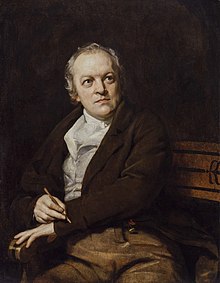
Back And did those feet in ancient time German And did those feet in ancient time Esperanto And did those feet in ancient time Basque And did those feet in ancient time French And did those feet in ancient time Galician And did those feet in ancient time IO And did those feet in ancient time Dutch And did those feet in ancient time NN And did those feet in ancient time NB And did those feet in ancient time SIMPLE
| And did those feet in ancient time | |
|---|---|
| by William Blake | |
 The preface to Milton, as it appeared in Blake's own illuminated version | |
| Written | 1804 |
| Country | United Kingdom |
| Language | English |
| Form | Epic poetry |
| Publication date | 1808 |
| Lines | 16 |
| Full text | |

"And did those feet in ancient time" is a poem by William Blake from the preface to his epic Milton: A Poem in Two Books, one of a collection of writings known as the Prophetic Books. The date of 1804 on the title page is probably when the plates were begun, but the poem was printed c. 1808.[1] Today it is best known as the hymn "Jerusalem", with music written by Sir Hubert Parry in 1916. The famous orchestration was written by Sir Edward Elgar. It is not to be confused with another poem, much longer and larger in scope and also by Blake, called Jerusalem The Emanation of the Giant Albion.
It is often assumed that the poem was inspired by the apocryphal story that a young Jesus, accompanied by Joseph of Arimathea, a tin merchant, travelled to what is now England and visited Glastonbury during his unknown years.[2] However, according to British folklore scholar A. W. Smith, "there was little reason to believe that an oral tradition concerning a visit made by Jesus to Britain existed before the early part of the twentieth century".[3] Instead, the poem draws on an older story, repeated in Milton's History of Britain, that Joseph of Arimathea, alone, travelled to preach to the ancient Britons after the death of Jesus.[4] The poem's theme is linked to the Book of Revelation (3:12 and 21:2) describing a Second Coming, wherein Jesus establishes a New Jerusalem. Churches in general, and the Church of England in particular, have long used Jerusalem as a metaphor for Heaven, a place of universal love and peace.[a]
In the most common interpretation of the poem, Blake asks whether a visit by Jesus briefly created heaven in England, in contrast to the "dark Satanic Mills" of the Industrial Revolution. Blake's poem asks four questions rather than asserting the historical truth of Christ's visit.[5][6] The second verse is interpreted as an exhortation to create an ideal society in England, whether or not there was a divine visit.[7][8]
- ^ Cox, Michael, editor, The Concise Oxford Chronology of English Literature, "1808", p 289, Oxford University Press, 2004, ISBN 0-19-860634-6
- ^ Icons – a portrait of England. Icon: Jerusalem (hymn) Feature: And did those feet? Archived 12 December 2009 at the Wayback Machine Accessed 7 August 2008
- ^ Smith, A. W. (1989). "'And Did Those Feet...?': The 'Legend' of Christ's Visit to Britain". Folklore. 100 (1). Taylor and Francis: 63–83. doi:10.1080/0015587X.1989.9715752. JSTOR 1260001.
- ^ Whittaker, Jason (5 September 2022). "Anti-empire, anti-fascist, pro-suffragist: the stunning secret life of Proms staple Jerusalem". The Guardian.
- ^ "What's your anthem?". The One Show. BBC. 17 October 2008. Retrieved 29 April 2011.
- ^ "Bring no spears to 'Jerusalem'". The Independent. 17 May 1996. Archived from the original on 7 November 2012.
- ^ "Great Poetry Explained". 25 February 2019. Retrieved 12 September 2020.
- ^ Rowland, Christopher (November 2007). "William Blake: a visionary for our time". OpenDemocracy. Retrieved 19 April 2020.
Cite error: There are <ref group=lower-alpha> tags or {{efn}} templates on this page, but the references will not show without a {{reflist|group=lower-alpha}} template or {{notelist}} template (see the help page).
© MMXXIII Rich X Search. We shall prevail. All rights reserved. Rich X Search